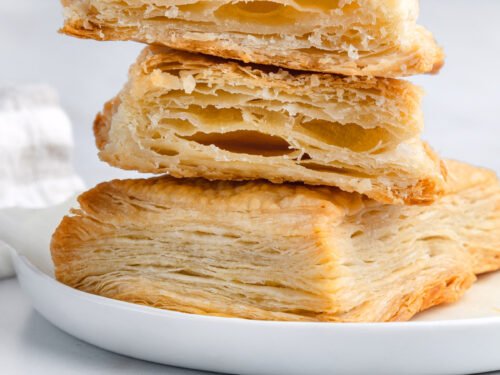Puff pastry is well-known laminated dough in world confectionery. Its layers are achieved by folds or folds, which are called “turns”. You can find the ingredients for this type of dough in any kitchen: flour, water, butter and salt. However, its preparation is not so simple, as it requires some dedication and some practice.
So, if you prepared puff pastry but it didn’t turn out as expected or you’re planning to do it for the first time, take a look at the best tricks to make puff pastry rise well that we share. You will be impressed with the result!
Why doesn’t puff pastry rise well?
The puff pastry grows because the butter encased in its folds boils during baking, its moisture joins with the moisture of the dough and both condense to form steam, which rises pushing the sheets. But what happens when the puff pastry doesn’t rise well? Mainly 4 factors occur:
- Inconstant temperature in process. During the preparation of the puff pastry, you must maintain two constant temperatures: very cold during kneading and before baking; and very hot during baking. Both allow the correct development of the dough in its different stages and, therefore, favor the obtaining of a tall and even puff pastry.
- Incorrect temperature during baking. If you exceed 220 °C, the puff pastry rises too quickly, for this reason it does not grow straight and tends to fail. On the contrary, if the temperature is below 220 °C, the development is slow, causing incomplete growth, cracking and absence of puffiness. Also, knowing everything about how to bake puff pastry is very important because it can help you a lot, since every detail counts at this stage of preparation.
- Improper kneading. Stretching the dough out too far at the edges, making it too thin in general, folding it incorrectly, or putting too much pressure on it are all bad practices during kneading that will compress the dough and prevent it from rising.
- Neglect the details. There are many things that can negatively affect our dough: inadequate flour, a bad cut, poor handling of the filling, etc. For this reason, it is very important to learn some tricks so that the puff pastry is crispy, and also rises well!
Don’t miss our easy puff pastry recipe.
Tricks to make puff pastry rise well
Believe it or not, achieving a good puff pastry depends above all on the details. For this reason, we have gathered the best tricks to make the puff pastry crisp and rise well:
- Use the appropriate flour. Strong flour is not suitable, as it is more difficult to stretch, laminate and requires more time to rest. On the other hand, loose flour requires less rest and is easy to work with during kneading, but it has more moisture and, if it is not subtracted properly from the recipe, it does not rise completely, it cracks and does not puff. The ideal flour is 000, as it allows better laminating, handles very well with the roller and requires almost no rest.
- Rectify the temperature of the dough every time you handle it. The puff pastry must be very cold, if not, you must put it in the fridge before rounding the dough and stretching it. Cover it with plastic wrap every time it remains in the fridge.
- The butter and the dough should be about the same temperature. When you put the butter into the dough, if it gets too soft, it won’t layer properly. For this reason, consider this recommendation one of the most relevant among the tricks to make the puff pastry crisp and grow correctly.
- Add the butter evenly and use equal thickness. Distribute it in this way over the entire surface, so you will get the dough to rise equally on all sides.
- Stretch the dough from the center to the edges. Avoid stretching it beyond that limit or the layers will be compressed, that is, due to the pressure exerted on the edges, the levels will not separate properly and consequently the puff pastry will not rise.
- Avoid pressing the dough too hard with the rolling pin as you roll it out. Manipulating it like this will also compress the layers.
- Check the edges of the dough as you fold. Try to make them even and not overlap.
- Use a very sharp knife to cut the puff pastry. In case you use pasta cutters, prefer one with a fine edge and never choose a pizza cutter for this task.
- Cut the puff pastry cleanly and without pressing the edges. Make a sharp cut, dropping the knife blade straight down. If the puff pastry is longer than the knife, lift it up and place the point just where you need to continue cutting. Never cut it as if you were slicing bread, because you drag the dough. If you don’t do this, even though the center of the puff pastry is properly separated, during baking the edges will stick together and you will end up with a pillow-like appearance.
- Leave the puff pastry with an approximate thickness of between 0.6 and 0.8 cm. If you exceed this measurement, the dough will not be crispy, and if it has less, it will not rise properly.
- Before baking, put the dough in the fridge or freezer. This way the butter solidifies and each level of the puff pastry is better formed. If you have little time, put it in the freezer for 10 minutes, if not refrigerate it.
- Preheat the oven. It is very important to keep the temperature constant since the puff pastry is introduced, otherwise it will adversely affect its growth.
- Bake the puff pastry at 220 °C. If you exceed this temperature, the puff pastry rises too quickly and may fall. On the contrary, a lower temperature will stop its growth and affect the puff pastry.
- Correct the time of the recipe according to the capacity of your oven. Home ovens differ from each other in the intensity of heat, so it is very important that you learn how to bake puff pastry by controlling the temperature and calculating the real time according to how yours is. Thinking about this, you have two options to better control the temperature: buy an oven thermometer or carry out preliminary tests before baking the final pieces.
- Prick the dough with a fork in the areas you don’t want to rise. This trick will help you in recipes that require a deep center for filling, for example some chocolate vole-au-vents.
- Brush only the surface, never the sides. Thus, you allow the dough to rise evenly, since the egg does not coagulate in those areas during cooking.
- Leave the mold or tray ungreased. The puff pastry itself is very greasy, so it is best to cover the utensil with parchment paper.
- Don’t open the oven. Opening it too soon will cause the puff pastry to lose moisture and therefore lose volume. Take this recommendation into account as you learn how to bake puff pastry correctly.
- Straighten crooked puff pastry while still hot. If you have a crooked piece, do not worry; straighten it carefully but quickly, because if it cools before it will break.
How to make the puff pastry not fall down?
Preparing puff pastry has its work, why are we going to deny it, but once the work is done, the satisfaction is very great. But, can you imagine that during baking or when it comes out of the oven the puff pastry falls down? Nobody wants that to happen, for this reason, the following tips and some tricks so that the puff pastry rises well and does not fall will be very useful:
- Respect the rest of the dough and put it in the fridge. Otherwise, during baking it will grow too large, and it will tend to collapse.
- Do not bake the puff pastry above 220°C. If you exceed this temperature, the puff pastry will rise too quickly, for this reason it will not grow straight and will tend to fall.
- Turn off the oven and leave the door open. Open it about 5 centimeters for 10 minutes, so the steam will escape slowly, losing heat from the oven. Thanks to this little trick, the puff pastry will not be exposed to a sudden change in temperature and, therefore, will maintain its size.
- Let it cool in a warm or temperate place. Avoid very drastic temperature contrast after taking it out of the oven. That is, neither excess cold, nor drafts.
What to do so that the puff pastry does not soften?
You observe your work with emotion, because the puff pastry has been perfect, it is tall, its growth is even, it is slightly golden, etc., now, it is your turn to fill it, what could go wrong? Well, the most common factor in these cases is temperature. Thinking about this, we will share with you some tricks so that the puff pastry does not get soft, it remains crispy and grows properly:
- Wait until the puff pastry cools well. As soon as it comes out of the oven, put it on a rack and let it rest. This applies more than anything in sweet preparations that have the filling on the outside.
- Chill the dessert in the fridge. Once stuffed, keep it there until serving time.
- Use only very cold and consistent fillings. This applies to both sweet and savory preparations. For savory fillings, use heavy cream or béchamel sauce to thicken them. Thus, you prevent the cooking vegetable juices from softening the dough. Consider this information among the most relevant among the tricks for crispy puff pastry because it works very well in preparations such as spinach, artichokes, mushrooms, sautéed vegetables, etc.
- If the puff pastry is to be served hot, reheat it in the oven at 180ºC. This way the heat will be distributed evenly and the dough will not become soft.



